|
|
|
Sort Order |
|
|
|
Items / Page
|
|
|
|
|
|
|
| Srl | Item |
| 1 |
ID:
194337


|
|
|
|
|
| Summary/Abstract |
The liberal international order (LIO) is now in a complex crisis. Its legitimacy and sustainability are put to the test with the growth of deglobalization forces, the rise of emerging powers dissatisfied with the LIO designed by the US, and climate change and the global pandemic. The crisis of the LIO is particularly salient in the Indo-Pacific, the epicenter of the US-China strategic competition, and secondary states in this region are increasingly concerned about its geopolitical consequences. However, I argue that secondary states often treated as the pawns of great powers can turn this circumstance to their advantage by adopting various strategies that maximize their leverage. We should take seriously the possibility that secondary states, by which I denote all states that are weaker or smaller than the hegemonic state and the rising power, can shape the contours of the US-China strategic competition and the newly emerging international order in the Indo-Pacific region. Preoccupied with great power politics, the existing literature on order transition has neglected the fact that secondary states can develop and exercise their own agency. Moreover, it remains vague what agency means in IR and how secondary states enact it. Against this backdrop, I propose an analytical framework that unpacks various types of agency along three dimensions—the motivation of agency, the type of mobilized resources, and the availability of partners. It will help us explain how weaker and smaller states participate and make their voice in reshaping international order in the Indo-Pacific.
|
|
|
|
|
|
|
|
|
|
|
|
|
|
|
|
| 2 |
ID:
181709
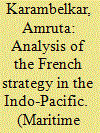

|
|
|
|
|
| Summary/Abstract |
France has emerged as a country with ambitions in the Indo-Pacific. It has vast territories, population and economic interests in the Indo-Pacific which necessitate a coherent national security policy towards this region. Even before the promulgation of its Indo-Pacific strategy, France has been involved in maritime Asia, primarily through defence sales. The changing balance of power has renewed European attention towards the Indo-Pacific wherein France is making its mark. This article studies the drivers of the French Indo-Pacific strategy and goes further to understand the fundamentals that have led to French attention to this region. A careful study of all major French policy articles lays out the strategic thinking in Paris. The article briefly presents bilateral and multilateral engagements of France. While traditional and non-traditional security issues and normative drive are apparent in the public discourse, it is clear that the major drivers are France's military–industrial complex and the desire to be able to influence the regional order.
|
|
|
|
|
|
|
|
|
|
|
|
|
|
|
|
| 3 |
ID:
195934


|
|
|
|
|
| Summary/Abstract |
ASEAN has played a crucial role in managing great power rivalry and maintaining regional stability amidst shifting geopolitical dynamics. As the regional order has evolved from East Asia to the broader Indo-Pacific, ASEAN has had to navigate an increasingly complex web of relationships between major powers, including the United States, China, and other regional players.
|
|
|
|
|
|
|
|
|
|
|
|
|
|
|
|
| 4 |
ID:
180758
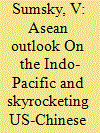

|
|
|
|
|
| Summary/Abstract |
For more than 10 years before that, the idea of the Indo-Pacific as a new regional configuration in the area of the Indian and Pacific Oceans to replace the Asia-Pacific Region construct had been bounced around at various international expert forums and in government circles of some countries, primarily the United States, Japan, Australia, and India. In 2007-2008, those four countries, which are more or less openly seeking to contain the growing economic and naval might of China, tried to create a quadrilateral group. They failed to establish any steady cooperation at that time, and for about the next 10 years, each of them sought to develop its own concept for a new regional formation while regularly attempting to coordinate positions with the other three in unofficial meetings on Indo-Pacific issues.
|
|
|
|
|
|
|
|
|
|
|
|
|
|
|
|
| 5 |
ID:
160611
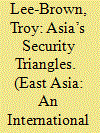

|
|
|
|
|
| Summary/Abstract |
Since the early years of the twenty-first century, a number of key regional governments have consciously chosen to alter the way they talk about the region, and have now largely shifted from using the ‘Asia-Pacific’ to the ‘Indo-Pacific’ construct. But after three decades of utilising the ‘Asia-Pacific’ concept, why has this been the case and how might this shift in geographical conceptualisation alter the strategic framework of the region? This paper argues that the ‘Indo-Pacific’ is a regional reconceptualisation utilised by Japan, Australia, India and the USA to address deficiencies in Asia’s maritime security and institutional architecture, which are being simultaneously influenced by a more assertive Chinese posture and waning U.S. influence. Additionally, the Indo-Pacific concept has developed in tandem with a transformation in the regional security architecture. The utilisation of maritime minilateralism between Japan, India, Australia and the USA supplements Asia’s bilateral American alliances, with an array of trilateral security dialogues or ‘security triangles’. The Asia-Pacific to Indo-Pacific shift is really an instance of an emerging minilateral security regionalism, rather than the predominant forms of bilateral and multilateral security and economic regionalism that have dominated Asia in recent decades.
|
|
|
|
|
|
|
|
|
|
|
|
|
|
|
|
| 6 |
ID:
192141
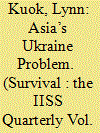

|
|
|
|
|
| Summary/Abstract |
Many Asian governments regard Russia’s war with Ukraine as a distant event with limited impact on the region, beyond rising food and energy prices and possibly increasing the risk of China attacking Taiwan. But the war has strained the rule of law and is entrenching ideological divisions, introducing unnecessary complexity into alliances and partnerships. Asian governments should be alert to the negative implications of these developments for regional peace and security. For them to condemn Russia’s invasion of Ukraine and defend the rule of law would not be to blindly support the West, and would be entirely consistent with their national interests. The West, for its part, should avoid worsening geopolitical fault lines. To this end, the United States might refrain from characterising great-power competition as a battle between autocracies and democracies, and from painting China and Russia with the same broad ideological brush.
|
|
|
|
|
|
|
|
|
|
|
|
|
|
|
|
| 7 |
ID:
182056
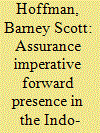

|
|
|
| 8 |
ID:
172564
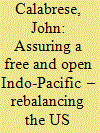

|
|
|
|
|
| Summary/Abstract |
Borrowing the term ‘Indo-Pacific’ from Japanese Prime Minister Shinzo Abe and refashioning the Obama ‘Pivot to Asia’ or ‘Rebalance Strategy’, the Trump administration has articulated a vision of a Free and Open Indo-Pacific (FOIP), which, as its public discourse and official documents reveal, is defined through the lens of great power competition with China. Since the latter part of 2017, the administration has laid the groundwork for a whole-of-government approach aimed at advancing this vision, which consists of three pillars: economy, governance, and security. Southeast Asia – a dynamic sub-region and the fulcrum of the wider Indo-Pacific – is central to the evolving US strategy. However, in its current form, that strategy casts China in the role of an existential threat and economic enemy, and seems overly focused on military security. For these reasons, it is unlikely to garner the full support of allies and partners – without which shared prosperity, good governance, and a peaceful and secure regional order across the Indo-Pacific cannot be assured. A repositioning and repurposing of the recently resuscitated Quadrilateral Security Dialogue (or Quad) could transform this minilateral platform into a useful instrument to coordinate the four members' actions, leverage the capabilities of Quad-Plus countries, and engage ASEAN in managing non-traditional security challenges and furthering its connectivity agenda.
|
|
|
|
|
|
|
|
|
|
|
|
|
|
|
|
| 9 |
ID:
143522
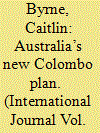

|
|
|
|
|
| Summary/Abstract |
The New Colombo Plan (NCP), a key plank in the Australian government’s foreign policy agenda, leverages student mobility as public diplomacy to improve Australia’s standing and influence within the Indo-Pacific region. Conceptualized as a “rite of passage” for young Australians, the NCP has been welcomed by Australian business, industry groups, and stakeholders because of its potential to deliver lasting relationships and practical economic benefits. Coordinated by the foreign affairs portfolio, the NCP represents a significant and distinct component of Australia’s public diplomacy, firmly aligned to advance the state’s economic diplomacy agenda. This paper explores the evolution of the NCP. It draws on stakeholder impressions from the program launch and pilot to explore early limitations and deeper soft power challenges. Findings suggest that the NCP is robust, yet key issues of strategic coherence, partnership, and evaluation require further attention if it is to deliver on its soft power promise.
|
|
|
|
|
|
|
|
|
|
|
|
|
|
|
|
| 10 |
ID:
191835
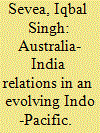

|
|
|
| 11 |
ID:
166102
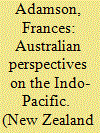

|
|
|
|
|
| Summary/Abstract |
Frances Adamson outlines Australia’s approach to regional co-operation and relations with New Zealand.
|
|
|
|
|
|
|
|
|
|
|
|
|
|
|
|
| 12 |
ID:
181708
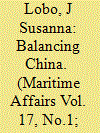

|
|
|
|
|
| Summary/Abstract |
The Indo-Pacific has emerged as an important region in international politics where the major powers are deeply engaged in reshaping the security architecture. Over the last few years, India and China have drawn their policies by employing competitive strategies that strengthen as well as neutralise their respective power positions in the Indian Ocean Region, particularly in South Asia and the South China Sea. China's “String of Pearls” strategy and the “Belt and Road Initiative” undermine India's influence in the Indian Ocean Region, where the changing geo-economic and geostrategic imperatives pose threat to its interests. This mounts pressure on New Delhi to respond by pursuing counter-strategies to secure its interests in the Indo-Pacific region. The article further explains how India and the United States’ interests are converging against an assertive China in the Indo-Pacific and how the two states’ security and maritime collaborations are balancing their common rival by maintaining a favourable status quo in the region.
|
|
|
|
|
|
|
|
|
|
|
|
|
|
|
|
| 13 |
ID:
190733
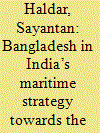

|
|
|
|
|
| Summary/Abstract |
This article looks at the potential of Bangladesh in India’s maritime strategy in the Bay of Bengal, in light of the shifting focus on the emergent Indo-Pacific. It argues that India’s maritime strategy in the Bay of Bengal is a driver of its wider engagement in the emerging Indo-Pacific. Therefore, engaging Bangladesh in the Bay of Bengal is strategically imperative for India. However, this requires New Delhi to deepen and expand its strategic convergences with Bangladesh and ensure that Dhaka warms up to the idea of an emergent Indo-Pacific that might even prompt geopolitical and geo-strategic competition with China.
|
|
|
|
|
|
|
|
|
|
|
|
|
|
|
|
| 14 |
ID:
190743
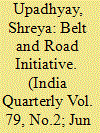

|
|
|
|
|
| Summary/Abstract |
The Belt and Road Initiative (BRI) is a China-led plan that involves infrastructure and construction projects in more than 140 countries, out of which 65 countries account for 30% of the world’s gross domestic product, 35% of the world’s trade, 39% of the global land, 64% of the world’s population, 54% of the world’s CO2 emissions and 50% of the world’s energy consumption (Du & Zhang, 2018, China Economic Review, 47, 189–205). The project announced in 2013 is often considered Chinese Premier Xi Jinping’s dream. It quickly grew in sectoral and geographical complexity from the Arctic to deep oceans, to Latin American countries, Africa and even collaborations in maritime and outer space. Nine years into the making, the project suffered disruption in the wake of the COVID-19 pandemic. Travel restrictions and lockdowns led to suspension and slowdown in the project. However, the Chinese leadership continues to remain optimistic regarding the BRI and is opting for digital, health and sustainability models to keep the initiative running. The article analyses the strategic and economic significance of the BRI from its inception to now. It focuses on the impact of the pandemic on the BRI and stakeholders’ responses to the project, and looks into attempts by China to make it a success in the post-pandemic world.
|
|
|
|
|
|
|
|
|
|
|
|
|
|
|
|
| 15 |
ID:
197989


|
|
|
|
|
| Summary/Abstract |
The Indo-Pacific context has gained increasing geopolitical focus over the last decade, and particularly over the last five years as powers such as the United States, Australia, the European Union (and three of its Member States – France, Germany and the Netherlands) have elaborated dedicated Indo-Pacific strategies. Underlying these has been a concern with the actions of China, defined through contested geopolitical discourses on its role as an actor in the region. While this contestation has been given some attention in academic literature, notably absent has been a consideration of the impact on regional states caught between these discursive tides, and particularly of the Pacific Island states (unsurprising, given the focus on the northern maritime arc that predominates in Indo-Pacific research). This article fills this gap through analysis of eight news media outlets (seven local and one regional) covering October–November 2019 and 2022, identifying the main discourses on China in Pacific media and their source, and examining the impact of these on local Pacific reporting. It finds that, notwithstanding the preponderance of ‘Western’ discourses on China’s role in Pacific media through republication of external media reporting, this does not translate into influence over Pacific reporting. Instead, it is Chinese discourses on its role that have the greatest resonance.
|
|
|
|
|
|
|
|
|
|
|
|
|
|
|
|
| 16 |
ID:
193449
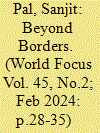

|
|
|
|
|
| Summary/Abstract |
This ar ticle explores the dynamic and complex landscape of strategic interactions in the vast Indo-Pacific region. In recent years, the Indo-Pacific has become the centre of global strategic competition. Begins with theconceptual framework and dynamics of Indo-Pacific, the article explores the current strategic priorities of major players like China, the United States, India, and regional alliances like ASEAN. Special attention is given to the maritime domain, where territorial disputes, resource competition, and naval presence contribute to the evolving strategic landscape.
|
|
|
|
|
|
|
|
|
|
|
|
|
|
|
|
| 17 |
ID:
197591


|
|
|
|
|
| Summary/Abstract |
This article examines continuity in the transformation of the United States’ security arrangements in Asia from a Cold War “hub and spokes system” focused on East Asia into a new arrangement of “networked minilateralism” across the wider “Indo-Pacific” region. It focuses mainly on the role of the United States and the policy tools it employs to coordinate the strengthening of linkages among its partners. By employing tools of defence diplomacy, standardisation in trade and infrastructure development, revamping the rhetoric of common values and inviting extra-regional actors to play a more active role in the Indo-Pacific, Washington is mobilising a “latticework” of partners that are assisting in the redesign of the regional security system and the balancing of China. At the same time, structural changes in the region’s power balance have induced local partners to become part of this networked architecture and to maintain a clearer sense of ownership in the regional security system.
|
|
|
|
|
|
|
|
|
|
|
|
|
|
|
|
| 18 |
ID:
183771
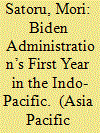

|
|
|
|
|
| Summary/Abstract |
The Biden administration’s engagement in the Indo-Pacific is driven by three major endeavors: balancing, order-building, and management of competition with China. The US is currently enhancing its balancing act by leveraging its alliance with Australia epitomized by AUKUS and the Enhanced Force Posture Cooperation launched by AUSMIN. Order-building advanced by the Quad is promoting three functions: regional public goods provision, mutual resilience enhancement, and standard-setting for critical and emerging technologies. The Biden administration is attempting to pursue “responsible competition” with China, but its ultimate goals remain undefined. Based on these observations, the article will conclude by pointing out major tasks that lie ahead for the Biden administration in these areas.
|
|
|
|
|
|
|
|
|
|
|
|
|
|
|
|
| 19 |
ID:
190074
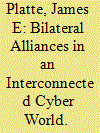

|
|
|
|
|
| Summary/Abstract |
During the Cold War, US extended deterrence commitments mostly focused on deterring nuclear or strategic conventional attacks against allies in Europe and Asia. In the decades following the end of the Cold War in the early 1990s, the emergence of new technologies and domains for conflict, particularly the cyber domain, prompted new thinking for alliance management and extended deterrence. In this article I explore how the system of US bilateral alliances and informal strategic groupings in the Indo-Pacific affects the crafting of allied cyber deterrence strategies in the region. Based on deterrence and alliance theory, I survey cyber threats faced by US allies and partners in the region and views of cyber deterrence to form a general framework of allied cyber deterrence strategy. The US-South Korea alliance is used as a case study for allied cyber deterrence strategy, with a special focus on the impact that South Korea assuming wartime operational control of allied military forces could have on cyber deterrence on the Korean Peninsula. Just as concepts of extended deterrence had to evolve, the cyber domain will force the United States and allies to reconceptualize peacetime and wartime operational control.
|
|
|
|
|
|
|
|
|
|
|
|
|
|
|
|
| 20 |
ID:
196530


|
|
|
|
|
| Summary/Abstract |
Chinese President Xi Jinping has since 2013 advocated for an “Asia-Pacific Community with a Shared Future” (APCSF). This concept has rekindled debates on regional integration. The article begins by critiquing conventional Eurocentric theories of community-building while highlighting fundamental features of the Asia-Pacific approach. It recounts erstwhile proposals put forward by Japan, Australia, and America, drawing comparisons with the emerging Chinese vision. The APCSF envisions an inclusive intergovernmental society of cooperative yet interdependent economies in the Asia-Pacific. Unlike the notion of Indo-Pacific, the idea of Asia-Pacific countries belonging to a community has deeper economic and psychological roots. Furthermore, what sets the APCSF apart from previous proposals is its solid foundation that aligns with its ambitious goals. It can draw upon existing initiatives such as the Regional Comprehensive Economic Partnership for Trade Liberalisation and the Belt and Road Initiative for enhancing connectivity. Consequently, the APCSF stands a better chance of eventual realisation.
|
|
|
|
|
|
|
|
|
|
|
|
|
|
|
|
|
|
|
|
|